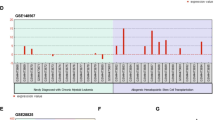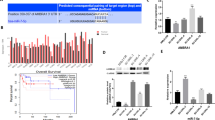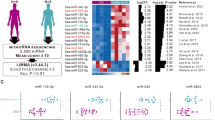Abstract
Chronic myeloid leukemia (CML) is a hematopoietic stem cell disease caused by abnormal DNA replication of bone marrow stem cells and chemotherapy resistance is a major obstacle to the effective treatment of patients with CML. Imatinib (IM), a tyrosine kinase inhibitor (TKI), is a first-line drug clinically used for CML. Mounting evidence has indicated that the dysregulation of microRNAs (miRNAs) is associated with the chemoresistance of CML. In this study, miR-153-3p, which had been implicated with numerous types of tumors, was identified to be downregulated in IM-resistant CML cells. Upregulation of miR-153-3p significantly increased IM sensitivity and decreased the survival rate of IM-resistant CML cells, whereas downregulation of miR-153-3p attenuated these effects in IM-resistant CML cells. Upregulated miR-153-3p could decrease the autophagy caused by IM in IM-resistant CML cells. Dual-luciferase reporter assays confirmed that Bcl-2 is a direct target of miR-153-3p. Bcl-2 restoration reversed the increased sensitivity to IM induced by miR-153-3p-mimic transfection in IM-resistant CML cells. The results of the present study showed that dysregulated miR-153-3p may target Bcl-2 to promote the development of IM resistance and attenuate IM-induced apoptosis in CML. Therefore, miR-153-3p upregulation combined with IM treatment may serve as a promising therapeutic strategy for patients with low sensitivity.





Similar content being viewed by others
Availability of data and material
The datasets used and/or analyzed in the current study are available from the corresponding author on reasonable request.
References
Branford S, Yeung DT, Parker WT, et al. Prognosis for patients with CML and %3e 10% BCR-ABL1 after 3 months of imatinib depends on the rate of BCR-ABL1 decline. Blood. 2014;124:511–8.
Druker BJ, O'Brien SG, Jorge C, Jerald R. Chronic myelogenous leukemia. Curr Opin Oncol. 2001;13:3.
Ruibao R. Mechanisms of BCR-ABL in the pathogenesis of chronic myelogenous leukaemia. Nat Rev Cancer. 2005;5:172–83.
Moraes GND, Souza PS, Costas FCDF, Vasconcelos FC, Maia RC. The Interface between BCR-ABL-dependent and -independent resistance signaling pathways in chronic myeloid leukemia. Leukemia Res Treatment. 2012;2012:671702.
Mollaei H, Safaralizadeh R, Rostami Z. MicroRNA replacement therapy in cancer. J Cell Physiol. 2019;234:12369–84.
Gottesman MM. Mechanisms of cancer drug resistance. Annu Rev Med. 2002;53:615–27.
Zhou J, Xie M, Shi Y, et al. MicroRNA-153 functions as a tumor suppressor by targeting SET7 and ZEB2 in ovarian cancer cells. Oncol Rep. 2015;34:111.
Cui Z, Luo Z, Lin Z, et al. Long non-coding RNA TTN-AS1 facilitates tumorigenesis of papillary thyroid cancer through modulating the miR-153-3p/ZNRF2 axis. J Gene Med. 2019;21:e3083.
Luan W, Shi Y, Zhou Z, et al. circRNA_0084043 promote malignant melanoma progression via miR-153-3p/Snail axis. Biochem Biophys Res Commun. 2018;502:22–9.
Jiang J, Liu Y, Zhao Y, Tian F, Wang G. miR-153-3p suppresses inhibitor of growth protein 2 expression to function as tumor suppressor in acute lymphoblastic leukemia. Technol Cancer Res Treatment. 2019;18:1533033819852990.
Shintani T, Klionsky DJ. Autophagy in health and disease: a double-edged sword. Science. 2004;306:990–5.
Ankit K, Umesh Kumar S, Anurag C. Targeting autophagy to overcome drug resistance in cancer therapy. Future Med Chem. 2015;7:1535–42.
Takahashi Y, Coppola D, Matsushita N, et al. Bif-1 interacts with Beclin 1 through UVRAG and regulates autophagy and tumorigenesis. Nat Cell Biol. 2007;9:1142–51.
Zhu J, Li Y, Huang C, Huang H. Abstract 3310: Atg7 overexpression promotes bladder cancer invasion via autophagic removal of AUF1 protein and subsequently increased RhoGDI2 mRNA stability in vitro and in vivo. Can Res. 2017;77:3310–410.
Rohatgi RA, Shaw LM. An autophagy-independent function for Beclin 1 in cancer. Mol Cell Oncol. 2016;3(1):e1030539.
Alexander Scarth W, Monika M, Anna KS. Autophagy in the pathogenesis of myelodysplastic syndrome and acute myeloid leukemia. Cell Cycle. 2011;10:1719–25.
Crowley LC, Elzinga BM, O'Sullivan GC, Mckenna SL. Autophagy induction by Bcr-Abl-expressing cells facilitates their recovery from a targeted or nontargeted treatment. Am J Hematol. 2011;86:38–47.
Cristian B, Maria Rosa L, Ashley H, et al. Targeting autophagy potentiates tyrosine kinase inhibitor-induced cell death in Philadelphia chromosome-positive cells, including primary CML stem cells. J Clin Investig. 2009;119:1109–23.
Beth L, Sangita S, Guido K. Bcl-2 family members: dual regulators of apoptosis and autophagy. Autophagy. 2008;4:600–6.
Manabu E, Ryungsa K, Kazuaki T, et al. Targeted therapy against Bcl-2-related proteins in breast cancer cells. Breast Cancer Res. 2005;7:R940–R952952.
Lin TY, Chen KC, Liu HJ, et al. MicroRNA-1301-mediated RanGAP1 downregulation induces BCR-ABL nuclear entrapment to enhance imatinib efficacy in chronic myeloid leukemia cells. PLoS ONE. 2016;11:e0156260.
Flis S, Chojnacki T. Chronic myelogenous leukemia, a still unsolved problem: pitfalls and new therapeutic possibilities. Drug Des Devel Ther. 2019;13:825–43.
Zhu X, Lin Z, Du J, et al. MicroRNA-320a acts as a tumor suppressor by targeting BCR/ABL oncogene in chronic myeloid leukemia. Sci Rep. 2015;5:12460.
Tanida I, Ueno T, Kominami E. LC3 and autophagy. Methods Mol Biol. 2008;445:77–88.
Jabbour EJ, Cortes JE, Kantarjian HM. Resistance to tyrosine kinase inhibition therapy for chronic myelogenous leukemia: a clinical perspective and emerging treatment options. Clin Lymphoma Myeloma Leukemia. 2013;13:515–29.
Lu Y, Liu LL, Liu SS, et al. Celecoxib suppresses autophagy and enhances cytotoxicity of imatinib in imatinib-resistant chronic myeloid leukemia cells. J Transl Med. 2016;14:270.
Testa U, Riccioni R. Deregulation of apoptosis in acute myeloid leukemia. Haematologica. 2007;92:81.
Colin J, Gaumer S, Guenal I, Mignotte B. Mitochondria, Bcl-2 family proteins and apoptosomes: of worms, flies and men. Front Biosci. 2008;14:4127–37.
Chiang W-C, Wei Y, Kuo Y-C, et al. High-throughput screens to identify autophagy inducers that function by disrupting Beclin 1/Bcl-2 binding. ACS Chem Biol. 2018;13:2247–60
Sun D, Mu Y, Piao H. MicroRNA-153-3p enhances cell radiosensitivity by targeting BCL2 in human glioma. Biol Res. 2018;51:56.
Funding
This work was supported by the scientific and innovative strategic special fund of Guangdong province (2018A030310299), doctor initiating scientific project of The Third Affiliated Hospital of Guangzhou Medical University (2017B07), and elite personnel project of The Third Affiliated Hospital of Guangzhou Medical University (2018001).
Author information
Authors and Affiliations
Contributions
Z-YL and Y-LL designed the research. Y-LL, Z-YL, J-MT, X-YC and BL performed the experiments, analyzed the data, and wrote the paper. G-HL performed the cell culture experiments. QQ collected the data and performed the statistical analyses.
Corresponding author
Ethics declarations
Conflict of interest
The authors declare that they have no conflict of interest.
Ethics approval and consent to participate
All human blood samples investigated in this study were in accordance with the ethical standards of the Ethics Committee of The Third Affiliated Hospital of Guangzhou Medical University, and with the 1964 Helsinki Declaration and its later amendments or comparable ethical standards. Informed consent was obtained from all individual sample donor included in the study.
Consent for publication
All authors have read and approved the publication of this paper.
Additional information
Publisher's Note
Springer Nature remains neutral with regard to jurisdictional claims in published maps and institutional affiliations.
Electronic supplementary material
Below is the link to the electronic supplementary material.
Rights and permissions
About this article
Cite this article
Li, YL., Tang, JM., Chen, XY. et al. MicroRNA-153-3p enhances the sensitivity of chronic myeloid leukemia cells to imatinib by inhibiting B-cell lymphoma-2-mediated autophagy. Human Cell 33, 610–618 (2020). https://doi.org/10.1007/s13577-020-00367-1
Received:
Accepted:
Published:
Issue Date:
DOI: https://doi.org/10.1007/s13577-020-00367-1




